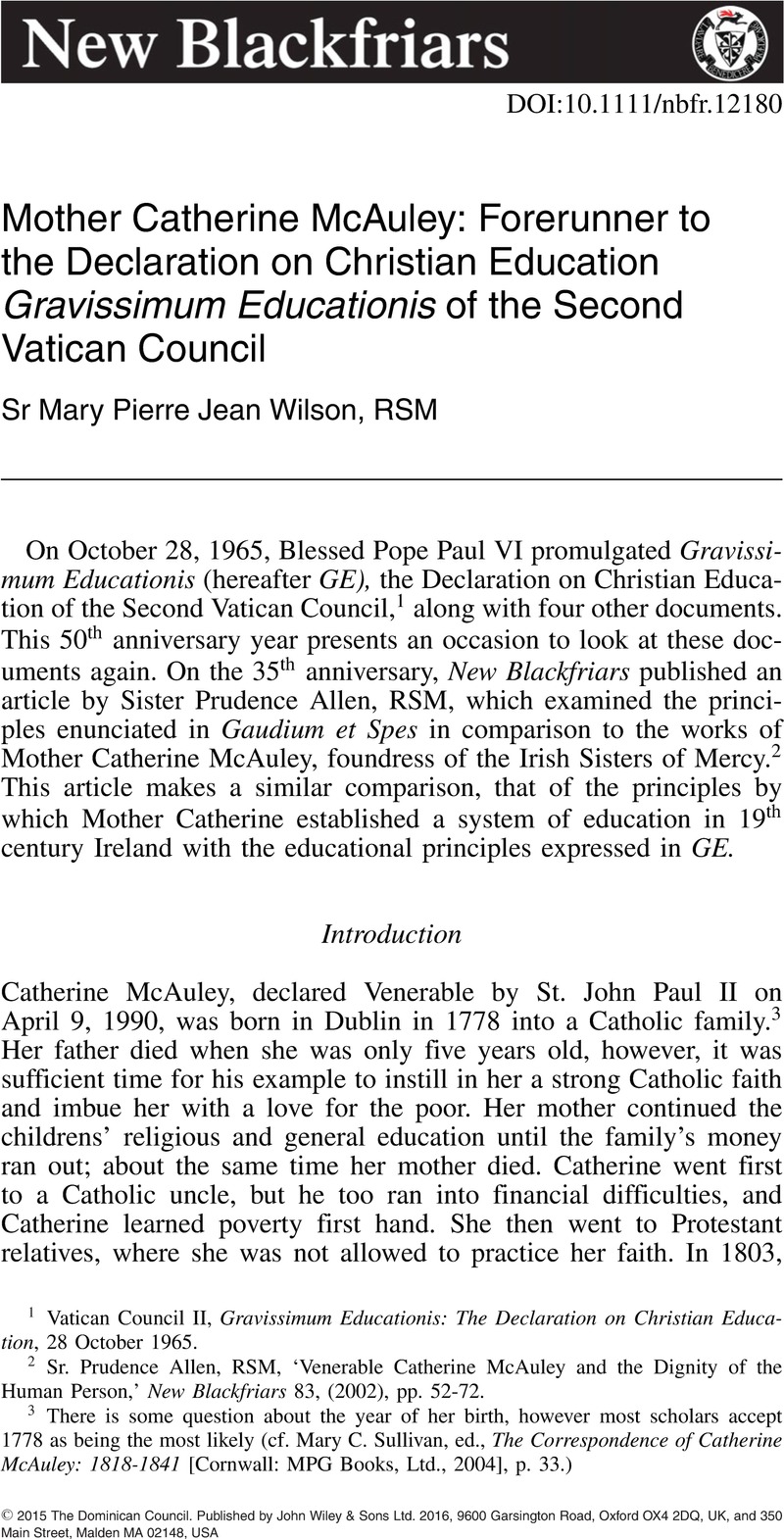No CrossRef data available.
Published online by Cambridge University Press: 01 January 2024

1 Vatican Council II, Gravissimum Educationis: The Declaration on Christian Education, 28 October 1965.
2 Sr.Allen, Prudence RSM, ‘Venerable Catherine McAuley and the Dignity of the Human Person,’ New Blackfriars 83, (2002), pp. 52-72CrossRefGoogle Scholar.
3 There is some question about the year of her birth, however most scholars accept 1778 as being the most likely (cf. Sullivan, Mary C., ed., The Correspondence of Catherine McAuley: 1818-1841 [Cornwall: MPG Books, Ltd., 2004], p. 33Google Scholar.)
4 Sister Bolster, M. Angela, Catherine McAuley: Venerable for Mercy (Dublin: Dominican Publications, 1990), p. 14Google Scholar.
5 Sister M. Angela Bolster, Documentary Study for the Canonisation Process for the Servant of God Catherine McAuley ... 1778-1841: Positio super Virtutibus (Prot. No. 1296) (hereafter “Positio”), p. 42.
6 Savage, Roland Burke S.J., Catherine McAuley: The First Sister of Mercy (Dublin: Gill, 1949), p. 267Google Scholar.
7 Ibid., p. 267.
8 The Rule and Constitutions of the Religious Sisters of Mercy, 1841, Ch. 2, n. 5, (https://ia700805.us.archive.org/22/items/ruleconstitution00sist/ruleconstitution00sist.pdf, cited 8 June 2015. See p. 75 for the recognitio of the Holy See in 1841 for correct date.)
9 Positio, p. 3.
10 GE, Preface.
11 Sister Bolster, M. Angela, Catherine McAuley: Prophet of Mercy (Cork: D. and A. O'Leary, 1996), p. 28Google Scholar.
12 No poor school was opened in Cork in order not to compete with the Presentation Sisters who already operated poor schools there and had no other apostolate (Positio, p. 716).
13 Pension schools were boarding schools in which a fee, or pension, was charged to cover the costs, thus restricting entrance to the wealthy. One of Mother Catherine's innovations was to open pension schools which were day schools instead of boarding schools, thus making them available to middle class girls because of the significantly lower cost. Cf. Carroll, Mother Austin, Leaves from the Annals of the Sisters of Mercy, Vol. I: Ireland (New York: Catholic Publication Society Co., 1881), p. 151Google Scholar.
14 Venerable for Mercy, p. 7.
15 Corcoran, T., Some Lists of Catholic Lay Teachers and their Illegal Schools in Later Penal Times (Dublin, 1932), p. 54Google Scholar, cited in Positio, pp. 712-713. See speech of May 21, 1832 on Ministerial Plan of Education, https://archive.org/stream/speechespublicle01ocon/speechespublicle01ocon_djvu.txt (cited August 20, 2015).
16 Positio, pp. 715-6.
17 McAuley, Mother Catherine, Sisters of Mercy of St. Joseph's Convent, StLouis, , ed., Familiar Instructions,. (St. Louis: Sisters of Mercy, 1888), 132Google Scholar. This book is a collection of notes taken by various Sisters of Mercy at conferences and other talks given by Mother Catherine to her Sisters.
18 Positio, p. 716.
19 Savage, p. 268.
20 Positio, p. 725.
21 Positio, p. 721.
22 Positio, p. 721-722.
23 See, for example, Address to the Staff and the Students of Saint Andrew's College of Education, Glasgow, June 1, 1982, n. 2; Discorso all'Organizzazione delle Nazioni Unite per l'Educazione, la Scienza e la Cultura (UNESCO), Paris, June 2, 1980, n. 18; Address to the Students, Teachers and Administrators of Rome's Schools, February 13, 1999, nn. 2-4 (available at http://w2.vatican.va/content/john-paul-ii/en.html, cited August 14, 2015.)
24 Citizens Information Board, http://www.citizensinformation.ie/en/education/primary_and_post_primary_education/going_to_primary_school/ownership_of_primary_schools.html, cited 8 June 2015.
25 Savage, p. 268; Positio, p. 717.
26 For example, see numerous sections of Dignitas Humanae; GE, 8, Lumen Gentium, 37, 39-43.
27 Familiar Instructions, Ch. 2, pp. 8-15.
28 The Rule and Constitutions of the Religious Sisters of Mercy, Ch. 2, nos. 1-2.
29 Savage, pp. 269-270.
30 Letter from Michael Blake, in Sister M. Angela Bolster, R.S.M., ed., The Correspondence of Catherine McAuley (Stoke-on-Trent, England: Webberly, ltd., 1989), p. 20.
31 Positio, p. 720.
32 Positio, p. 716, footnote 34.
33 Positio, p. 727.